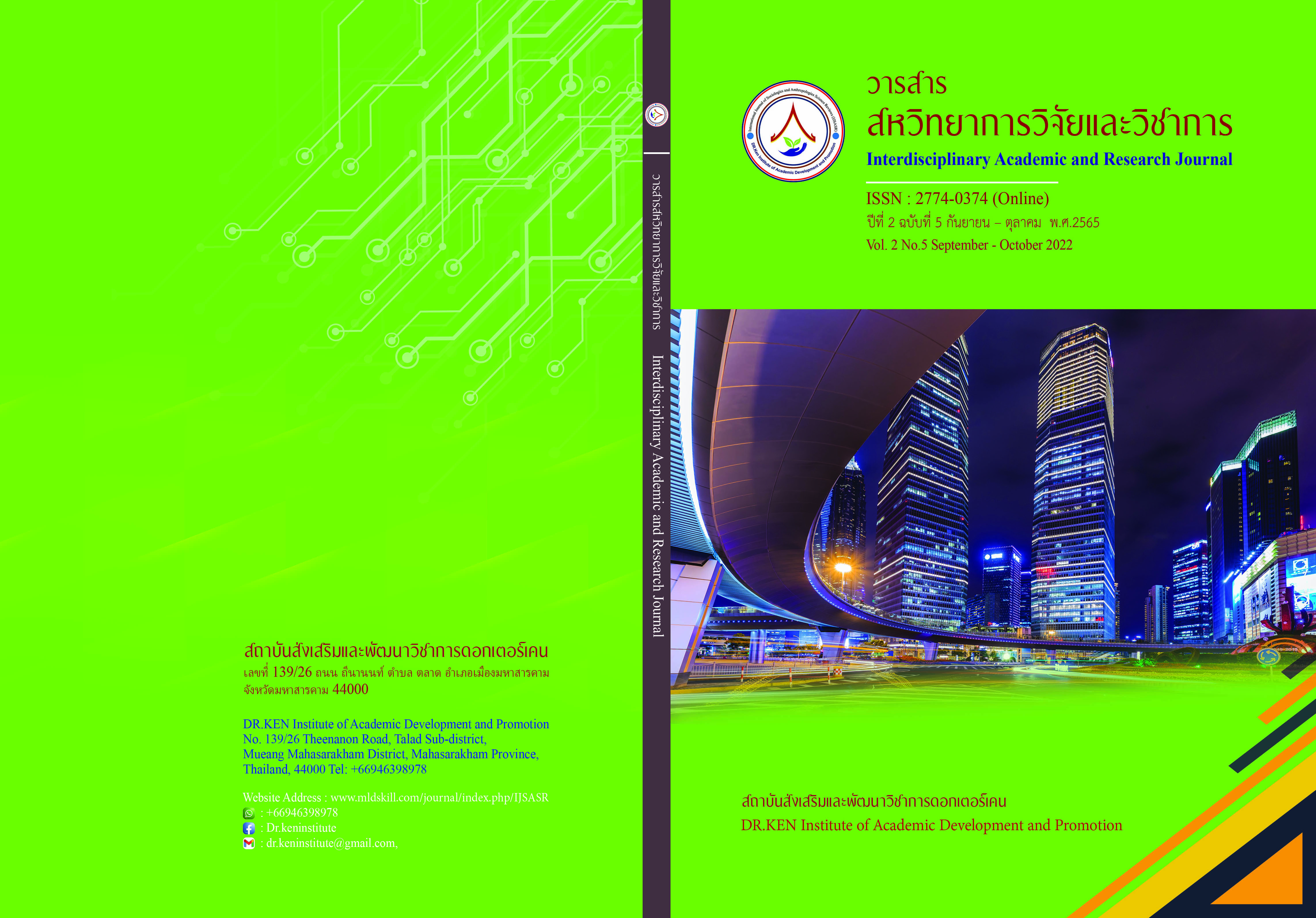Study the Problems Conditions and Guidelines on Operational Development as Professional Learning Community of Educational Institutions under Local Government Organization, Kalasin Province
DOI:
https://doi.org/10.14456/iarj.2022.121Keywords:
Conditions of Operations Problems; , Guidelines of Operations Development; , Professional Learning Community, , Educational Institutions;, Local Government OrganizationsAbstract
One of the most important mechanisms for successful learning transformation is the paradigm shift in the management of educational institutions to “The Learning School”, by providing a “Professional Community” within the educational institution. This is to provide a platform with a learning atmosphere and culture for all members to exchange knowledge and experiences with each other, including creating new knowledge and innovations that are suitable for modern teaching and learning management. Thus, the purpose of this study is to 1) study the operating conditions of professional learning communities in schools. Department of Local Administration Promotion of Karasin Province Department of Local Administration Promotion of Karasin Province 235 local administrators in Karasin Province was obtained by multi-step random sampling and informants. It is composed of 9 qualified personnel and is obtained by selecting specific tools. The tools used include questionnaires. The confidence value of a structured interview is 0.99. The statistics used are percentage, average, and standard deviation. The results found that (1) Problems found in community professional learning of educational institutions subordinate to local administrative organizations in Karasin Province: On the whole, the problem is moderate. (2) Vocational Learning Community Development Guide for Educational Institutions under the Ministry of Local Administration of Karasin Province In terms of co-leadership, meetings should be held to clarify and understand the scope of the learning community. Through the workshop of the PLC team of each school on the common vision and goal. Students should develop their knowledge and abilities according to their potential through Professional Learning Community activities in teamwork. A clear operating calendar should be established to analyze everyone's problems together, determine the method to solve the problem, and follow up on the results. It shall constantly report the results of learning and professional development activities and propose and exchange technologies. The various learning management methods of the Kalayanamitr community should start with the participation of all relevant parties at the classroom level. Groups, regions, and communities build professional learning communities through workshops and performance demonstrations. In terms of the community support structure, a clear team should be established to perform various tasks and clearly define the responsibilities of joint work. The review shall accept the opinions of all parties and put forward opinions to reflect the performance. The strengths and weaknesses shall be analyzed. And where it should be developed.
References
กระทรวงศึกษาธิการ. (2562). การจัดการเรียนรู้ในศตวรรษที่ 21. กรุงเทพฯ: โรงพิมพ์แห่งจุฬาลงกรณ์มหาวิทยาลัย.
ประจักษ์ ศรสาลี และคณะ (2563). ชุมชนการเรียนรู้ทางวิชาชีพ PLC (Professional Learning Community) สพป.กำแพงเพชร เขต 1. [Online] https://sites.google.com/a/esdc.go.th/kpt1-plc/?tmpl=%2Fsystem%2Fapp%2Ftemplates%2Fprint%2F&showPrintDialog=1 [26 มีนาคม 2563]
ปิยณัฐ กุสุมาลย์ และภมรพรรณ์ ยุระยาตร์. (2560). แนวทางการพัฒนาครูโดยใช้แนวคิดชุมชนแห่งการเรียนรู้ทางวิชาชีพในการจัดการเรียนรู้ สำหรับสถานศึกษา สังกัดสำ นักงานเขตพื้นที่การศึกษามัธยมศึกษา เขต 27. วารสารการบริหารและนิเทศการศึกษา มหาวิทยาลัยมหาสารคาม. 8 (1), 196-206.
ปองทิพย์ เทพอารีย์ และ ปองทิพย์ เทพอารีย์ และ มารุต พัฒผล. (2557). การพัฒนารูปแบบชุมชนแห่งการเรียนรู้เชิงวิชาชีพสำหรับครูประถมศึกษา. วารสารศิลปากรศึกษาศาสตร์วิจัย. 6 (2), 284-296.
วรลักษณ์ ชูกำเนิด เอกรินทร์ สังค์ทอง และชวลิต เกิดทิพย์. (2557). รูปแบบชุมชนการเรียนรู้ทางวิชาชีพครูสู่การเรียนรู้ในศตวรรษที่ 21 บริบท โรงเรียนในประเทศไทย. วารสารหาดใหญ่วิชาการ. 12(2), 123-134.
วิจารณ์ พานิช. (2555). วิถีสร้างการเรียนรู้เพื่อศิษย์ในศตวรรษที่ 21. กรุงเทพมหานคร: มูลนิธิสดศรี-สฤษดิ์วงศ์.
วิทยากร เชียงกลู. (2559).รายงานสภาวะการศึกษาไทย ปี 2557/2558 จะปฏิรูปการศึกษาไทยให้ทันโลกในศตวรรษที่ 21 ได้อย่างไร. กรุงเทพฯ : พิมพ์ดีการพิมพ์ จำกัด.
สถาบันวิจัยเพื่อการพัฒนาประเทศไทย. (2557). การจัดทำยุทธศาสตร์การปฏิรูปการศึกษาขั้นพื้นฐานให้เกิดความรับผิดชอบ. กรุงเทพฯ: สถาบันวิจัยเพื่อการพัฒนาประเทศไทย.
สรศักดิ์ นิมากร และเสาวนี สิริสุขศิลป์. (2560). แนวทางการพัฒนาชุมชนแห่งการเรียนรู้ทางวิชาชีพของโรงเรียนเฉพาะความพิการทางด้านร่างกายหรือการเคลื่อนไหวหรือสุขภาพ สังกัดสำนักบริหารงานการศึกษาพิเศษ. วรสารวิจัยและพัฒนาการศึกษาพิเศษ. 6 (2), 66-76.
สำนักงานเลขาธิการสภาการศึกษา. (2552). สภาพการจัดการศึกษาในจังหวัดชายแดนภาคใต้. กรุงเทพฯ : วี.ที.ซี. คอมมิวนิเคชั่น.
สุเทพ พงศ์ศรีวัฒน์. (2555). ผู้นำสถานศึกษากับการสร้างโรงเรียนแห่งการเรียนรู้. [Online] http:/www.sutept.crru.ac.th/leader31.doc. [21 มีนาคม 2555]
สุมาลี สังข์ศรี. (2556). การเรียนรู้ตลอดชีวิตสำหรับประเทศไทย. (พิมพ์ครั้งที่ 2). นนทบุรี: สำนักพิมพ์มหาวิทยาลัยสุโขทัยธรรมาธิราช.
สุรพล ธรรมร่มดี, ทัศนีย์ จันอินทร์, และคงกฤช ไตรยวงค์. (2553). อาศรมศิลป์วิจัย: การวิจัยและพัฒนาชุมชนแห่งการเรียนรู้ แนวจิตตปัญญา. โครงการเอกสารวิชาการการเรียนรู้สู่ การเปลี่ยนแปลง ลำดับที่ 8. นครปฐม: เอมี่ เอ็นเตอร์ไพรส์ จำกัด
อนุสรา สุวรณวงศ์. (2559). คุณลักษณะของชุมชนแห่งการเรียนรู้ทางวิชาชีพในบริบทการศึกษาไทย. วารสารปัญญาภิวัฒน์. 8 (1), 163-175.
Krejcie, R. V., & Morgan, D. W. (1970). Determining sample size for research activities. Educational and Psychological Measurement, 30(3), 607–610.
Downloads
Published
How to Cite
Issue
Section
License
Copyright (c) 2022 กรรณิกา บุญวิเทียน, ศักดิ์สิทธิ์ ฤทธิลัน, รัชฎาพร งอยภูธร

This work is licensed under a Creative Commons Attribution-NonCommercial-NoDerivatives 4.0 International License.
Copyright on any article in the Interdisciplinary Academic and Research Journal is retained by the author(s) under the under the Creative Commons Attribution-NonCommercial-NoDerivatives 4.0 International License. Permission to use text, content, images, etc. of publication. Any user to read, download, copy, distribute, print, search, or link to the full texts of articles, crawl them for indexing, pass them as data to software, or use them for any other lawful purpose. But do not use it for commercial use or with the intent to benefit any business.
















.png)


